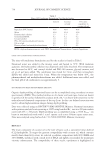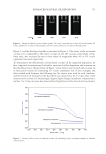677 THE MATRIX REVISITED of this effect will be proportional to the severity of the treatment and the resulting number of cleaved disulfide bonds. Although tensile measurements provide some hints to the matrix chemistry and how the balance of the different bonds contribute to its mechanics, deeper investigation of the matrix requires other approaches. An especially precise alternative involves the use of AFM. This technique allows for the evaluation of the mechanical properties of the matrix with superior resolution, limited only by the size of the indenter tip. When this technique was investigated for examining the matrix mechanics, it was noticed that performing indentation on cross sections could not distinguish the effect of matrix filling the space between KIFs. This is because the resolution of the measurement, about 50 nm, is larger than the mean space between KIFs, which is about 10 nm (17). To overcome this difficulty, an elegant solution was employed, whereby information was acquired on the matrix by performing indentation on the longitudinal sections of the fiber (18). Figure 4 shows results obtained by using AFM to investigate the properties of bleached and virgin fibers by this approach. This figure emphasizes the importance of using longitudinal sections during examination. Whereas the modulus values extracted from indentation of the cross sections of bleached and virgin fibers are not very different, the data for the longitudinal sections show the effects of bleaching on fiber mechanics, especially at low RH. The two-phase model (see Figure 1) suggests that hair fibers consist of a composite material of rods embedded in a matrix. This allows the equations of Voigt (19) and Reuss (20) to be used to describe the elastic moduli of composite materials at axial and transverse stresses of E Axial and E Trans , respectively, in terms of the contributions of the moduli of the rods, E KIF, and the matrix, E Matrix . In this way, the modulus of the matrix can be evaluated from the AFM measurements on cross sections and longitudinal sections as (3) E E E E E E Matrix Trans KIF Axial KIF Trans = - - (5) By using Equations 2–4, one can evaluate the modulus of the matrix from the contribution of the disulfide and hydrogen bonds for both virgin and bleached fibers as (3) E k n E Virgin Matrix N S EWC)1/3 = ⋅ + ( 1- (6) and E k n E′ Bleached Matrix N S EWC)1/3 = + ⋅ + -0.022RH 4 0e . (1- (7) where n is the number of water molecules required to break a hydrogen bond EWC is the equilibrium water content of the fiber, which depends on RH and E S and E′ S are the elastic contributions of disulfide bonds to the virgin fibers and after the breaking of some fibers by bleaching, respectively. Based on the AFM measurements and Equations 6 and 7, the Young’s modulus of virgin matrix at 0% RH was estimated to be about 1.8 GPa, and that of bleached matrix at 0% RH was estimated to be about 5.5 GPa (3). The difference is interpreted as being due to the
Figure 4. Elastic moduli of virgin and bleached fibers measured at various RH values on (A) Axial measurements (cross section) and (B) Transverse measurements (longitudinal section) of the fibers (18). 678 JOURNAL OF COSMETIC SCIENCE
Purchased for the exclusive use of nofirst nolast (unknown) From: SCC Media Library & Resource Center (library.scconline.org)






































































































































